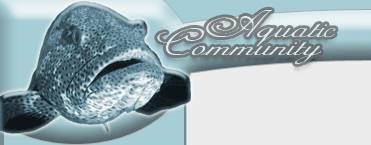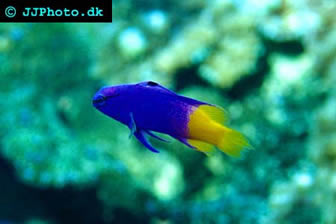Royal Gramma
Gramma loreto
The fish species Gramma loreto is known under several different names in English, such as Royal Gramma and Fairy Basslet.
Gramma loreto has not been evaluated for the IUCN Red List of Threatened Species.
Geographical distribution, habitat and habits
The Royal Gramma is found in the Western Atlantic, from Bermuda and Bahamas, through the waters of Central America, and down to the northern part of South America.
This is a reef associated species that likes to under ledges or in caves and its depth range is 1-60 meters / 3-200 feet. It is known to swim upside down under ledges.
Size and appearance
The largest scientifically measured Royal Gramma was 8.0 cm / 3.1 in.
This is a bicoloured fish; the front half is purple while the behind is bright orange-yellow. Under water, the purple colour usually looks blue. The two colours contrasts beautifully against each other.
Royal Gramma care
The Royal Gramma is a comparatively hardy saltwater fish and it is often kept by novice marine aquarists. It is not advisable to house it in an aquarium smaller than 30 gallons / 115 litres. The aquarium should contain plenty of caves, crevices and rocks. Don’t use sharp lighting. This species is considered reef compatible and is often kept in small reef aquariums since it doesn’t grow very big. It can be kept singly or in pairs, or as a small group if your aquarium is large enough.
The Royal Gramma is relatively peaceful, but it will chase away small fish that tries to occupy its favourite caves and crevices. It can decide to fight fishes similar to it self, such as other members of the family Grammatidae, dottybacks and dwarf seabass. Avoid combining it with more aggressive fishes that might attach it.
The recommended water temperature is 72-78° F / 22-25.5° C. The pH-value should be between 8.1 and 8.4 and the specific gravity at 1.020-1.025.
Feeding Royal Gramma
In the wild, the Royal Gramma works as a cleaner fish, removing ectoparasites from other fishes. (An ectoparasite is a parasite that lives on or in the skin of the fish.) In the aquarium, it can be trained to accept small meaty foods, e.g. brine shrimp and mysis shrimp. It can also learn to eat dead food, e.g. crustacean flesh, fish flesh, and frozen preparations for carnivores. The Royal Gramma is not considered tricky to feed in aquariums.
Breeding Royal Gramma
When it is time to breed, the male Royal Gramma will build a nest among rocks using pieces of algae. He will then lead the female fish into the nest where she will deposit 20-100 tiny eggs among the algae strands. Throughout the breeding period, this behaviour can be repeated almost every day for a month or even longer.
The eggs are normally about 1 mm / 0.04 in and equipped with small protuberances over the surface, with tiny threads extending from them. These threads make it possible for the eggs to stay attached to the algae inside the nest. You can expect the eggs to hatch after 5-7 days, typically in the evening when it is dark.
Royal Gramma has been successfully bred in captivity. You can feed the fry rotifers until they have grown big enough to devour newly hatched brine shrimp.
Gramma Articles
Brazilian Gramma – Gramma brasiliensis
Blackcap Gramma – Gramma melacara

